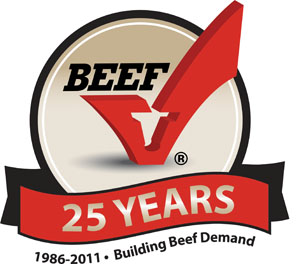 The beef checkoff recently published a white paper titled, "Animal Age, Physiological Maturity, and Associated Effects on Beef Tenderness", by J. Daryl Tatum, Ph.D., Colorado State University.
The beef checkoff recently published a white paper titled, "Animal Age, Physiological Maturity, and Associated Effects on Beef Tenderness", by J. Daryl Tatum, Ph.D., Colorado State University. Conventional U.S. cattle-production systems are designed to provide consumers with a consistent supply of high-quality, grain-fed beef, which is preferred in current mainstream U.S. beef markets (both domestic and export). In grain-fed beef production systems, beef calves (steers and heifers) typically are reared on pastures with their dams until they are five- to eight-months old. After weaning, calves either are placed in feedlots immediately for grain finishing (as "calf-feds") or grown for a period of time on forage-based diets, until they are 12 to 18 months old, before placement in feedlots for finishing (as "yearlings" or "long-yearlings"). Grain-finished cattle produced in the United States normally are harvested between 12 and 24 months of age.
When beef carcasses are presented for quality grading, USDA graders examine visible indicators of physiological maturity, which are used to classify carcasses into maturity groups. At these young ages, steers and heifers are expected to produce A-maturity carcasses when they are graded by USDA. However, some of these cattle exhibit sufficient degrees of skeletal ossification to cause their carcasses to be classified as B-maturity or older, which significantly reduces carcass value and marketability. The purpose of this review was to examine and summarize existing scientific information concerning production-level effects on physiological maturation processes in cattle and examine the relationships of these effects to the occurrence of advanced beef carcass maturity characteristics. Click here to read the full white paper. For more information about your beef checkoff, visit MyBeefCheckoff.com.
The Beef Checkoff Program was established as part of the 1985 Farm Bill. The checkoff assesses $1 per head on the sale of live domestic and imported cattle, in addition to a comparable assessment on imported beef and beef products. States retain up to 50 cents on the dollar and forward the other 50 cents per head to the Cattlemen's Beef Promotion and Research Board, which administers the national checkoff program, subject to USDA approval.
12.21.2011